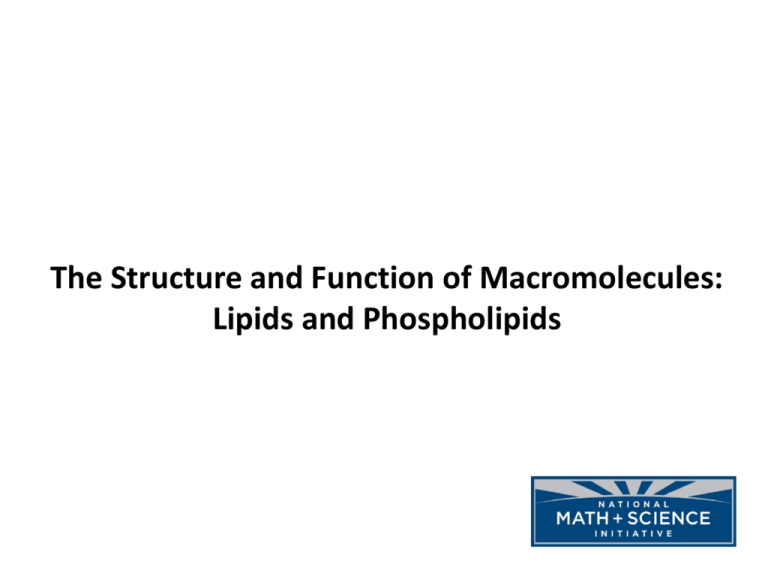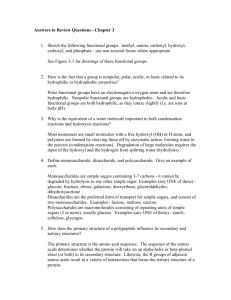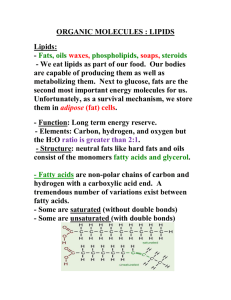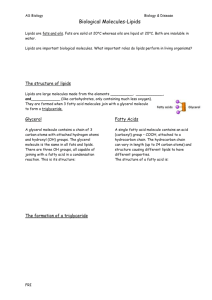File
advertisement

The Structure and Function of Macromolecules: Lipids and Phospholipids Lipids Are Hydrophobic Lipids are a diverse group of hydrophobic molecules • Lipids are the one class of large biological molecules that do not form polymers • The unifying feature of lipids is having little or no affinity for water (water fearing) • Lipids are hydrophobic because they consist mostly of hydrocarbons, which form nonpolar covalent bonds • The most biologically important lipids are fats, phospholipids, and steroids 2 Fats: Start with a Simple Little Glycerol Molecule • Fats are constructed from two types of smaller molecules: glycerol and fatty acids • Glycerol is a three-carbon alcohol with a hydroxyl group attached to each carbon • A fatty acid consists of a carboxyl group attached to a long carbon skeleton 3 Dehydration Rxn 1: Add a Fatty Acid • Next, add a “fatty acid” through a dehydration synthesis reaction • What makes it an acid? The C double bond O, single bond OH! 4 Dehydration Rxn 2!! • Next, add a SECOND “fatty acid” through a dehydration synthesis reaction Dehydration Reaction THREE!!! • The joining of the C of the fatty acid to the O of the hydroxyl group of the glycerol is called an ester linkage. 6 Fats Are Insoluble In Aqueous Environments • Fats separate from water because water molecules form hydrogen bonds with each other and exclude the fats • In a fat, three fatty acids are joined to glycerol by an ester linkage, creating a triacylglycerol, or triglyceride 7 Saturated or Unsaturated? • Fats made from saturated fatty acids are called saturated fats, and are solid at room temperature • Most animal fats are saturated (lard) • Saturated fatty acids have the maximum number of hydrogen atoms possible and no double bonds 8 Saturated or Unsaturated? • Fats made from unsaturated fatty acids are called unsaturated fats or oils, and are liquid at room temperature • Plant fats and fish fats are usually unsaturated • Unsaturated fatty acids have one or more double bonds 9 Saturated or Unsaturated? • A diet rich in saturated fats may contribute to cardiovascular disease through plaque deposits • Hydrogenation is the process of converting unsaturated fats to saturated fats by adding hydrogen 10 What’s a Trans fat? • Hydrogenating vegetable oils also creates unsaturated fats with trans double bonds • These trans fats may contribute more than saturated fats to cardiovascular disease 11 Saturated or Unsaturated? • Certain unsaturated fatty acids are not synthesized in the human body • These must be supplied in the diet • These essential fatty acids include the omega-3 fatty acids, required for normal growth, and thought to provide protection against cardiovascular disease 12 Fats: Major function is storage! • The major function of fats is energy storage • Humans and other mammals store their fat in adipose cells • Adipose tissue also cushions vital organs and insulates the body 13 Phospholipids • When phospholipids are added to water, they selfassemble into a bilayer, with the hydrophobic tails pointing toward the interior • The structure of phospholipids results in a bilayer arrangement found in cell membranes • Phospholipids are the major component of all cell membranes 14 Hydrophobic tails Hydrophilic head A Single Phospholipid Molecule Choline Phosphate Glycerol Fatty acids Hydrophilic head Hydrophobic tails (a) Structural formula (b) Space-filling model (c) Phospholipid symbol Steroids • Steroids are lipids characterized by a carbon skeleton consisting of four fused rings • Cholesterol, an important steroid, is a component in animal cell membranes • Although cholesterol is essential in animals, high levels in the blood may contribute to cardiovascular disease 16 Created by: René McCormick National Math and Science Dallas, TX








